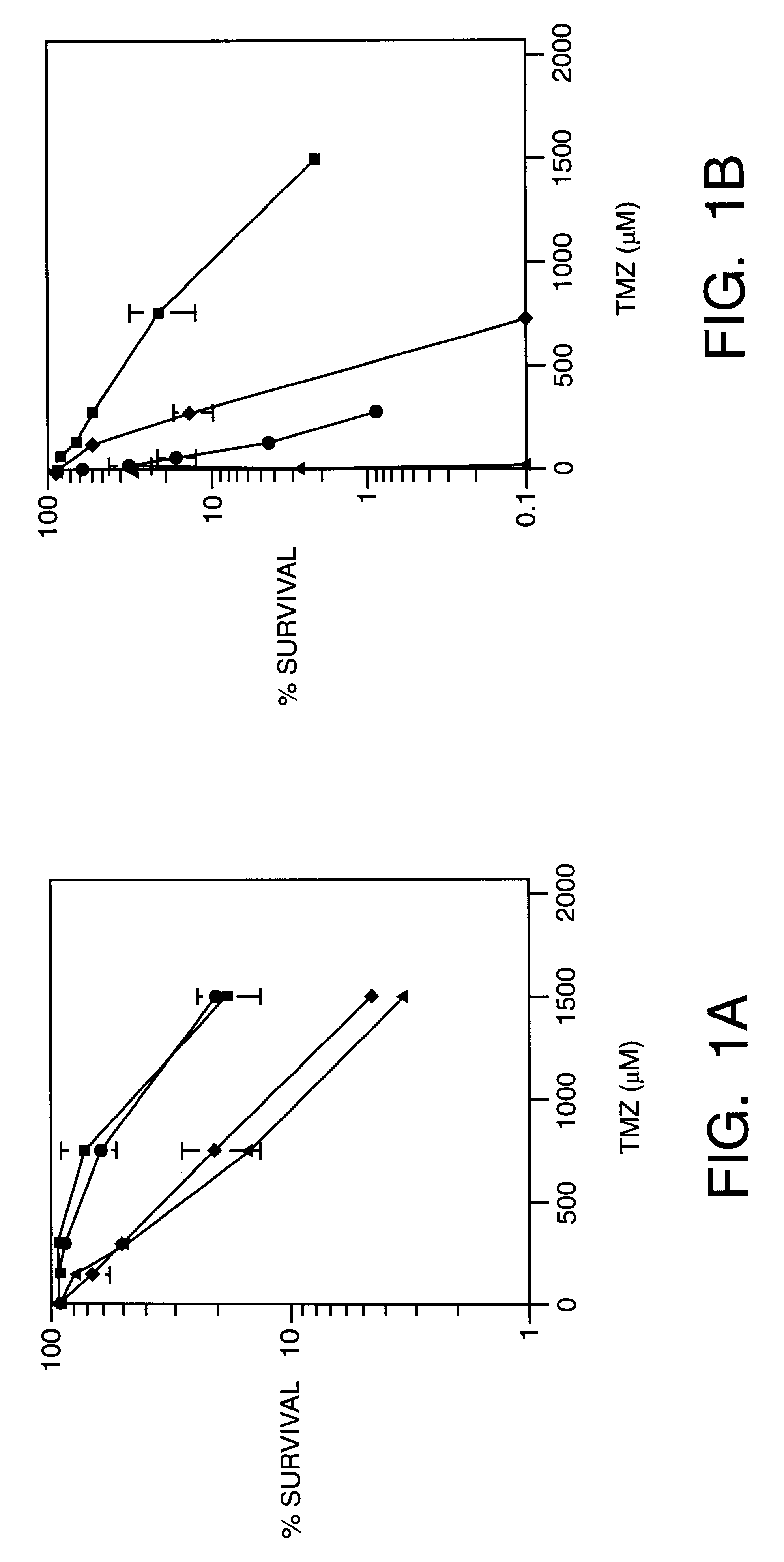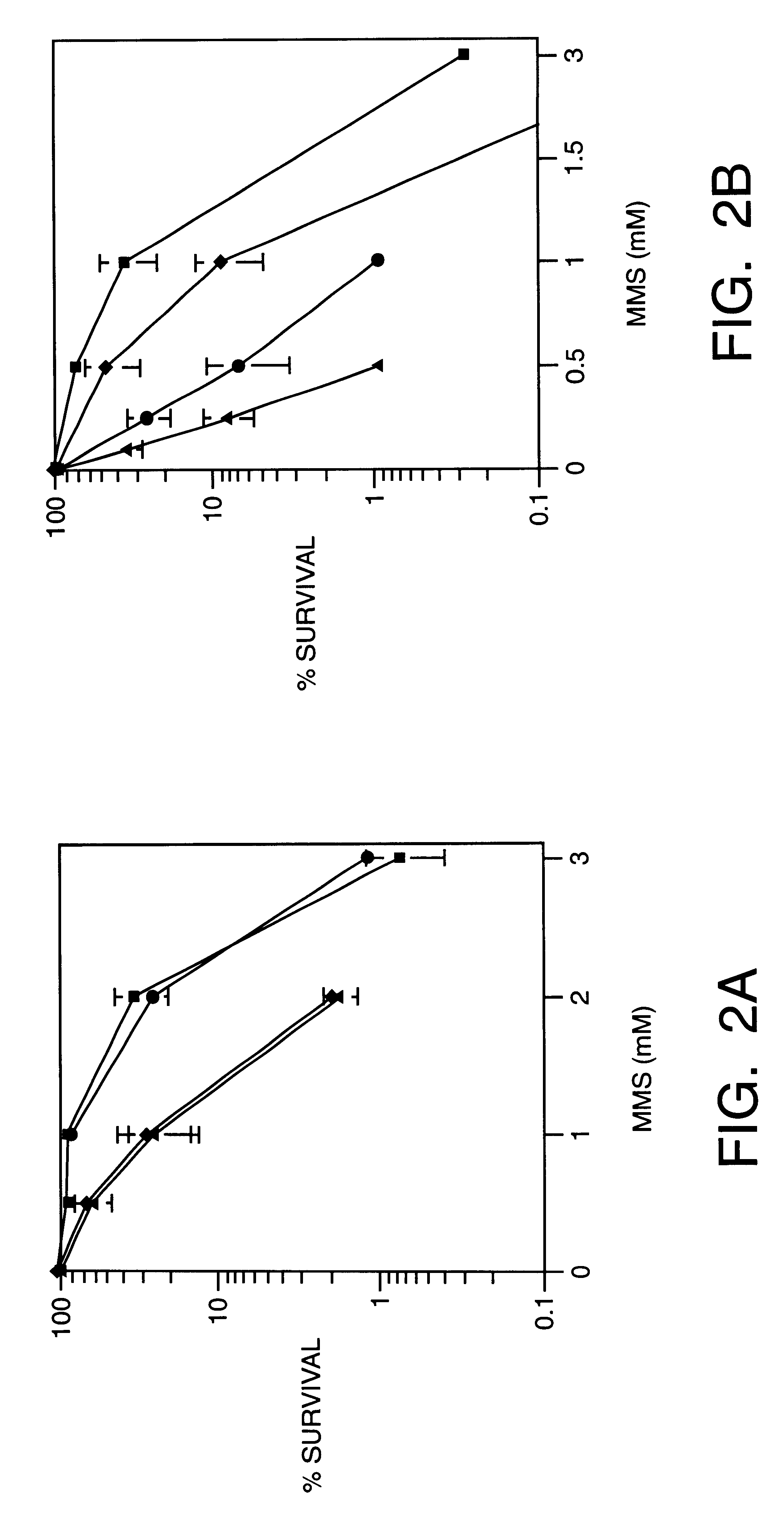Methoxyamine potentiation of temozolomide anti-cancer activity
a technology of temozolomide and methoxyamine, which is applied in the direction of heterocyclic compound active ingredients, biocide, drug compositions, etc., can solve the problems of inability to process o.sup, achieve potentiation activity, prevent ape cleavage, and disrupt dna repair
- Summary
- Abstract
- Description
- Claims
- Application Information
AI Technical Summary
Benefits of technology
Problems solved by technology
Method used
Image
Examples
example 2
Inhibitors of PARP Modulate the Sensitivity of Cells to TMZ
Since inhibitors of PARP may interrupt BER and increase sensitivity to methylating agents, we examined whether inhibitors of PARP sensitize cells to TMZ. FIG. 3a and FIG. 4a ((.box-solid.), TMZ alone; (.diamond-solid.), BG plus TMZ; (.circle-solid.), PD128763 plus TMZ; (.tangle-solidup.), BG and TMZ plus PD128763) display survival after combined treatment of TMZ with PD128763, 3-AB or 6-AN in both SW480 and, HCT116 cells. In the SW480 cell line, PD128763 sensitized cells to TMZ with a DMF of 3.3 fold. The combination of PD128763, BG TMZ was even more toxic, with a DMF compared to TMZ alone of 36-fold. In HCT116 cells, the DMF for PD128763 and TMZ compared to TMZ alone was 5.0. However, the combination of PD128763, BG and TMZ had no greater effect than PD128763 and TMZ, indicating that persistent O.sup.6 mG had no effect on cytotoxicity in this MMR defective cell line. Potentiation of TMZ cytotoxicity was also observed in bot...
example 3
Synergistic Interaction Between TMZ and MX or PD128763
We investigated the nature of the reaction between TMZ and MX in the TMZ-resistant cell line, HCT116. These cells were incubated in the presence of a range of concentrations of TMZ (75-750 .mu.M), of MX (1.5-15.0 mM), or constant molar ratio mixture of TMZ and MX (1:20) for 2 hr. HCT116 cells were also exposed to TMZ and PD128763 (62.5-625 .mu.M) alone and to a combination of (1:0. 83) for 2 hr to analyze synergism. As shown in FIG. 5A and 5B, synergistic interaction (CI<<1, p<0.001) was found in both SW480 cells and, HCT116 cells using the combination of TMZ with either MX or PD128763. These results also showed a marked synergism at high Fa values. Since MDF for these combinations was similar to the observed with SW480 cells, we conclude that BER inhibitor synergizes methylating agent cytotoxicity in both MMR deficient and proficient colon cancer cells.
example 4
Effect of BER Inhibitors on BCNU Cytotoxicity
To test whether MX is also able to sensitize colon cancer cells to chloroethylating agents, these two cell lines were pretreated with 6 mM MX for 2 hr followed by BCNU. No enhancement of BCNU cytotoxicity by MX was observed (FIG. 6); the BCNU IC.sub.50 was 45 .mu.M in HCT116 cells (FIG. 6A: (.box-solid.), BCNU alone; (.diamond-solid.), MX plus BCNU; (.circle-solid.), BG plus BCNU; (.tangle-solidup.), BG plus MX plus BCNU) and 27-29 .mu.M in SW480 cells, respectively, treated with BCNU alone or BCNU plus MX (FIG. 6B: (.box-solid.), BCNU alone; (.diamond-solid.), MX plus BCNU; (.circle-solid.), BG plus BCNU; (.tangle-solidup.), BG plus MX plus BCNU). A greater sensitization to BCNU was observed in these two cell lines when cells were treated with MX plus BG and BCNU, in which the BCNU IC.sub.50 for both cell lines was 5 .mu.M. However, most of the effect was potentiated due to BG, which increased BCNU cytotoxicity by 3-4 fold. As shown in F...
PUM
| Property | Measurement | Unit |
|---|---|---|
| Dimensionless property | aaaaa | aaaaa |
| Dimensionless property | aaaaa | aaaaa |
| Dimensionless property | aaaaa | aaaaa |
Abstract
Description
Claims
Application Information
 Login to View More
Login to View More - R&D
- Intellectual Property
- Life Sciences
- Materials
- Tech Scout
- Unparalleled Data Quality
- Higher Quality Content
- 60% Fewer Hallucinations
Browse by: Latest US Patents, China's latest patents, Technical Efficacy Thesaurus, Application Domain, Technology Topic, Popular Technical Reports.
© 2025 PatSnap. All rights reserved.Legal|Privacy policy|Modern Slavery Act Transparency Statement|Sitemap|About US| Contact US: help@patsnap.com



